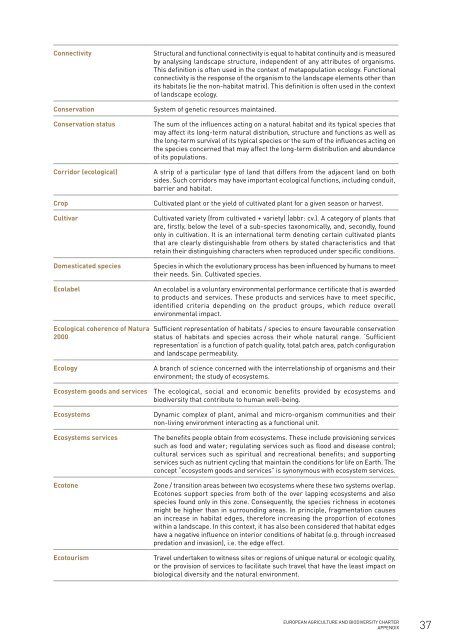agriculture - Reverse, European Project to Preserve Biodiversity
agriculture - Reverse, European Project to Preserve Biodiversity
agriculture - Reverse, European Project to Preserve Biodiversity
Create successful ePaper yourself
Turn your PDF publications into a flip-book with our unique Google optimized e-Paper software.
Connectivity Structural and functional connectivity is equal <strong>to</strong> habitat continuity and is measured<br />
by analysing landscape structure, independent of any attributes of organisms.<br />
This definition is often used in the context of metapopulation ecology. Functional<br />
connectivity is the response of the organism <strong>to</strong> the landscape elements other than<br />
its habitats (ie the non-habitat matrix). This definition is often used in the context<br />
of landscape ecology.<br />
Conservation System of genetic resources maintained.<br />
Conservation status The sum of the influences acting on a natural habitat and its typical species that<br />
may affect its long-term natural distribution, structure and functions as well as<br />
the long-term survival of its typical species or the sum of the influences acting on<br />
the species concerned that may affect the long-term distribution and abundance<br />
of its populations.<br />
Corridor (ecological) A strip of a particular type of land that differs from the adjacent land on both<br />
sides. Such corridors may have important ecological functions, including conduit,<br />
barrier and habitat.<br />
Crop Cultivated plant or the yield of cultivated plant for a given season or harvest.<br />
Cultivar Cultivated variety (from cultivated + variety) (abbr: cv.). A category of plants that<br />
are, firstly, below the level of a sub-species taxonomically, and, secondly, found<br />
only in cultivation. It is an international term denoting certain cultivated plants<br />
that are clearly distinguishable from others by stated characteristics and that<br />
retain their distinguishing characters when reproduced under specific conditions.<br />
Domesticated species Species in which the evolutionary process has been influenced by humans <strong>to</strong> meet<br />
their needs. Sin. Cultivated species.<br />
Ecolabel An ecolabel is a voluntary environmental performance certificate that is awarded<br />
<strong>to</strong> products and services. These products and services have <strong>to</strong> meet specific,<br />
identified criteria depending on the product groups, which reduce overall<br />
environmental impact.<br />
Ecological coherence of Natura<br />
2000<br />
Sufficient representation of habitats / species <strong>to</strong> ensure favourable conservation<br />
status of habitats and species across their whole natural range. ‘Sufficient<br />
representation’ is a function of patch quality, <strong>to</strong>tal patch area, patch configuration<br />
and landscape permeability.<br />
Ecology A branch of science concerned with the interrelationship of organisms and their<br />
environment; the study of ecosystems.<br />
Ecosystem goods and services The ecological, social and economic benefits provided by ecosystems and<br />
biodiversity that contribute <strong>to</strong> human well-being.<br />
Ecosystems Dynamic complex of plant, animal and micro-organism communities and their<br />
non-living environment interacting as a functional unit.<br />
Ecosystems services The benefits people obtain from ecosystems. These include provisioning services<br />
such as food and water; regulating services such as flood and disease control;<br />
cultural services such as spiritual and recreational benefits; and supporting<br />
services such as nutrient cycling that maintain the conditions for life on Earth. The<br />
concept “ecosystem goods and services” is synonymous with ecosystem services.<br />
Eco<strong>to</strong>ne Zone / transition areas between two ecosystems where these two systems overlap.<br />
Eco<strong>to</strong>nes support species from both of the over lapping ecosystems and also<br />
species found only in this zone. Consequently, the species richness in eco<strong>to</strong>nes<br />
might be higher than in surrounding areas. In principle, fragmentation causes<br />
an increase in habitat edges, therefore increasing the proportion of eco<strong>to</strong>nes<br />
within a landscape. In this context, it has also been considered that habitat edges<br />
have a negative influence on interior conditions of habitat (e.g. through increased<br />
predation and invasion), i.e. the edge effect.<br />
Eco<strong>to</strong>urism Travel undertaken <strong>to</strong> witness sites or regions of unique natural or ecologic quality,<br />
or the provision of services <strong>to</strong> facilitate such travel that have the least impact on<br />
biological diversity and the natural environment.<br />
EUROPEAN AGRICULTURE AND BIODIVERSITY CHARTER<br />
APPENDIX 37



